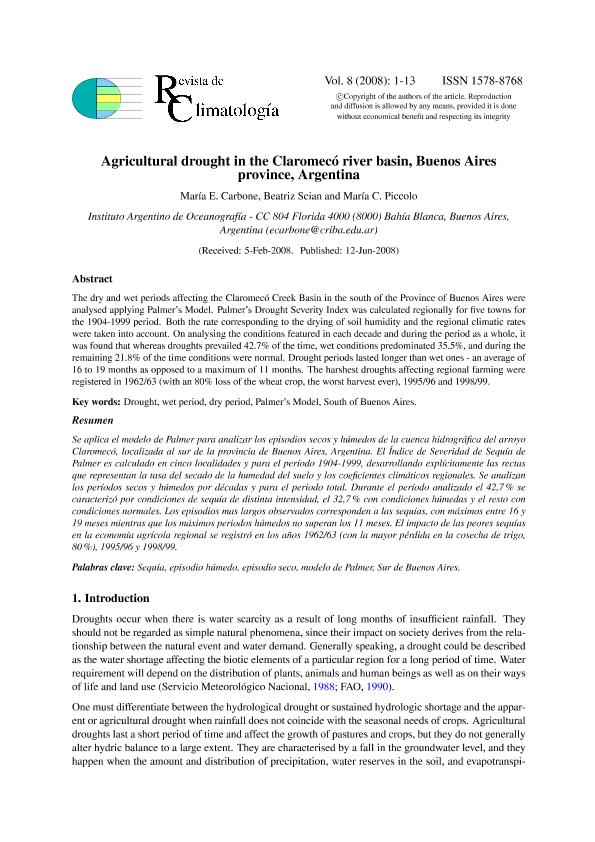Mostrar el registro sencillo del ítem
dc.contributor.author
Carbone, Maria Elizabeth

dc.contributor.author
Scian, Beatriz
dc.contributor.author
Piccolo, Maria Cintia

dc.date.available
2017-11-23T16:37:30Z
dc.date.issued
2008-12
dc.identifier.citation
Carbone, Maria Elizabeth; Scian, Beatriz; Piccolo, Maria Cintia; Agricultural drought in the Claromecó river basin, Buenos Aires province, Argentina; Revista de Climatología; Revista de Climatología; 8; 2008; 12-2008; 1-13
dc.identifier.issn
1578-8768
dc.identifier.uri
http://hdl.handle.net/11336/28868
dc.description.abstract
The dry and wet periods affecting the Claromecó Creek Basin in the south of the Province of Buenos Aires were analysed applying Palmer’s Model. Palmer’s Drought Severity Index was calculated regionally for five towns for the 1904-1999 period. Both the rate corresponding to the drying of soil humidity and the regional climatic rates were taken into account. On analysing the conditions featured in each decade and during the period as a whole, it was found that whereas droughts prevailed 42.7% of the time, wet conditions predominated 35.5%, and during the<br />remaining 21.8% of the time conditions were normal. Drought periods lasted longer than wet ones - an average of 16 to 19 months as opposed to a maximum of 11 months. The harshest droughts affecting regional farming were registered in 1962/63 (with an 80% loss of the wheat crop, the worst harvest ever), 1995/96 and 1998/99.
dc.description.abstract
Se aplica el modelo de Palmer para analizar los episodios secos y húmedos de la cuenca hidrográfica del arroyo Claromecó, localizada al sur de la provincia de Buenos Aires, Argentina. El Índice de Severidad de Sequía de Palmer es calculado en cinco localidades y para el período 1904-1999, desarrollando explícitamente las rectas que representan la tasa del secado de la humedad del suelo y los coeficientes climáticos regionales. Se analizan los períodos secos y húmedos por décadas y para el periodo total. Durante el período analizado el 42,7 % se caracterizó por condiciones de sequía de distinta intensidad, el 32,7 % con condiciones húmedas y el resto con condiciones normales. Los episodios mas largos observados corresponden a las sequías, con máximos entre 16 y 19 meses mientras que los máximos periodos húmedos no superan los 11 meses. El impacto de las peores sequías en la economía agrícola regional se registró en los años 1962/63 (con la mayor pérdida en la cosecha de trigo, 80 %), 1995/96 y 1998/99.
dc.format
application/pdf
dc.language.iso
eng
dc.publisher
Revista de Climatología
dc.rights
info:eu-repo/semantics/openAccess
dc.rights.uri
https://creativecommons.org/licenses/by-nc-sa/2.5/ar/
dc.subject.classification
Meteorología y Ciencias Atmosféricas

dc.subject.classification
Ciencias de la Tierra y relacionadas con el Medio Ambiente

dc.subject.classification
CIENCIAS NATURALES Y EXACTAS

dc.title
Agricultural drought in the Claromecó river basin, Buenos Aires province, Argentina
dc.type
info:eu-repo/semantics/article
dc.type
info:ar-repo/semantics/artículo
dc.type
info:eu-repo/semantics/publishedVersion
dc.date.updated
2017-11-16T14:40:36Z
dc.journal.volume
8
dc.journal.number
2008
dc.journal.pagination
1-13
dc.journal.pais
España

dc.journal.ciudad
Islas Baleares
dc.description.fil
Fil: Carbone, Maria Elizabeth. Consejo Nacional de Investigaciones Científicas y Técnicas. Centro Científico Tecnológico Conicet - Bahía Blanca. Instituto Argentino de Oceanografía. Universidad Nacional del Sur. Instituto Argentino de Oceanografía; Argentina
dc.description.fil
Fil: Scian, Beatriz. Consejo Nacional de Investigaciones Científicas y Técnicas. Centro Científico Tecnológico Conicet - Bahía Blanca. Instituto Argentino de Oceanografía. Universidad Nacional del Sur. Instituto Argentino de Oceanografía; Argentina
dc.description.fil
Fil: Piccolo, Maria Cintia. Consejo Nacional de Investigaciones Científicas y Técnicas. Centro Científico Tecnológico Conicet - Bahía Blanca. Instituto Argentino de Oceanografía. Universidad Nacional del Sur. Instituto Argentino de Oceanografía; Argentina
dc.journal.title
Revista de Climatología
dc.relation.alternativeid
info:eu-repo/semantics/altIdentifier/url/https://doaj.org/article/c8f341ba37124b5e87fd45c71701ccf4
dc.relation.alternativeid
info:eu-repo/semantics/altIdentifier/url/http://webs.ono.com/reclim3/reclim08a.pdf
Archivos asociados
